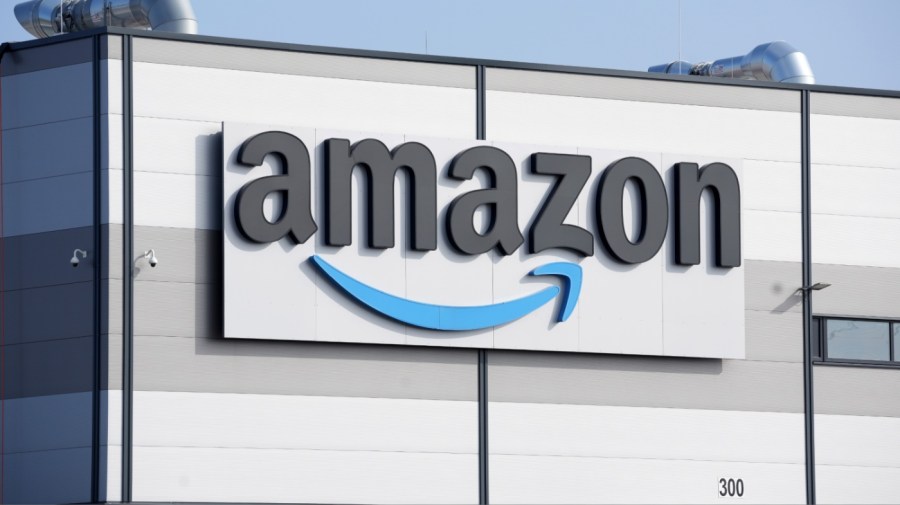Business
What to know about the ‘Make Amazon Pay’ strike campaign on November 24, 2023 at 6:31 pm Business News | The Hill

Thousands of Amazon workers and supporters worldwide staged protests Friday and planned more for Cyber Monday to demand the world’s largest retailer improve worker conditions, lessen its carbon footprint and pay more in taxes.
The Make Amazon Pay campaign isn’t anticipated to get in the way of Black Friday shopping, but seeks to send a message to Amazon founder Jeff Bezos and company leadership.
Here’s what you need to know:
It’s billed as the largest Amazon strike day ever
More than 80 labor and climate organizations are supporting protest and strike efforts at Amazon facilities worldwide, according to the groups involved.
Organizers said strikes and protests would take place in more than 30 countries Friday.
An organizer with GMB Union, a U.K.-based labor union, described the effort as “the largest day of industrial disruption in Amazon’s thirty-year history.”
The effort garnered support from more than 400 lawmakers from 38 countries for a protest in 2020, including Rep. Rashida Tlaib (D-Mich.) and former U.K. Labour leader Jeremy Corbyn.
Protests and walkouts span multiple continents
While much of Europe will see protests Friday, workers at an Amazon facility in Joliet, Ill., pledged to also walk out in solidarity with the effort. There was also a planned strike of Teamsters members in Palmdale, Calif., organizers said.
Supporters also planned protests at Amazon facilities in Massachusetts, Georgia and Illinois. Outside the U.S., organizers planned protest action in Japan, India and throughout Europe, including Germany, France, Spain and the U.K.
Hundreds of workers were striking Friday at warehouses in Coventry, U.K., and in multiple German cities, Reuters reported.
It is the fourth year of the campaign
This year marks the fourth consecutive annual protest for Make Amazon Pay, launched amid the COVID-19 pandemic, as Amazon saw record profits with an increase in online shopping.
The 2022 effort focused on 30 countries, specifically 18 warehouses in France and Germany, according to organizers UNI Global Union and Progressive International.
While there were also protests in the U.S. and worldwide, last year’s campaign was much smaller than what organizers planned for Black Friday and Cyber Monday in 2023.
“This day of action grows every year because the movement to hold Amazon accountable keeps getting bigger and stronger,” Christy Hoffman, general secretary of UNI Global Union, said in a statement.
“Workers know that it doesn’t matter what country you’re in or what your job title is, we are all united in the fight for higher wages, an end to unreasonable quotas, and a voice on the job,” Hoffman added.
Protesters demand worker benefits, climate action
The global protest movement is aimed at encouraging Amazon to improve its working conditions, including increased pay, more adequate breaks and benefits, as well as additional sick leave.
The same issues are at the center of labor fights with Amazon in the U.S., after multiple Amazon warehouses faced union votes in the last two years. The company’s Staten Island, N.Y., warehouse is currently the only unionized facility in the U.S. after a vote in April 2022.
Protesters also demand that the company replace part-time employment with full-time jobs, stop anti-union efforts and bargain with negotiating workers in good faith.
The effort also hopes to encourage Amazon to further commit to lowering its carbon footprint and pay more in taxes to countries it operates in, protesters said.
Amazon defends employee pay, benefits
Amazon has pushed back on the claims promoted by protesters, saying the “vast majority of these allegations are false or misinformed.”
“The fact is Amazon has created millions of good jobs, while helping create and support hundreds of thousands of small businesses around the world. We offer great pay and benefits for our employees,” Amazon spokesperson Mary Kate Paradis said in a statement to The Hill, “with great career opportunities, and provide a modern and safe working environment for all.
“We continue to invest in the countries and communities where we operate, and we’re proud to be the world’s largest corporate purchaser of renewable energy,” Paradis added. “That’s part of our drive to be net zero carbon by 2040, with billions already invested in packaging reduction, clean energy and electric vehicles.”
Brad Dress contributed to this report.
Business, Blog Briefing Room, Blogs, Labor, Regulation, Amazon, Black Friday, Cyber Monday, labor unions, Strikes Thousands of Amazon workers and supporters worldwide staged protests Friday and planned more for Cyber Monday to demand the world’s largest retailer improve worker conditions, lessen its carbon footprint and pay more in taxes. The Make Amazon Pay campaign isn’t anticipated to get in the way of Black Friday shopping, but seeks to send a…
Business
Why 9 Million Americans Have Left

The Growing American Exodus
Nearly 9 million Americans now live outside the United States—a number that rivals the population of several states and signals a profound shift in how people view the American dream. This mass migration isn’t confined to retirees or the wealthy. Thanks to remote work, digital nomad visas, and mounting pressures at home, young professionals, families, and business owners are increasingly joining the ranks of expats.

Rising Costs and Shrinking Wallets
Living in the US has become increasingly expensive. Weekly grocery bills topping $300 are not uncommon, and everyday items like coffee and beef have surged in price over the last year. Rent, utilities, and other essentials also continue to climb, leaving many Americans to cut meals or put off purchases just to make ends meet. In contrast, life in countries like Mexico or Costa Rica often costs just 50–60% of what it does in the US—without sacrificing comfort or quality.
Health Care Concerns Drive Migration
America’s health care system is a major trigger for relocation. Despite the fact that the US spends more per person on health care than any other country, millions struggle to access affordable treatment. Over half of Americans admit to delaying medical care due to cost, with households earning below $40,000 seeing this rate jump to 63%. Many expats point to countries such as Spain or Thailand, where health care is both affordable and accessible, as a major draw.

Seeking Safety Abroad
Public safety issues—especially violent crime and gun-related incidents—have made many Americans feel unsafe, even in their own communities. The 2024 Global Peace Index documents a decline in North America’s safety ratings, while families in major cities often prioritize teaching their children to avoid gun violence over simple street safety. In many overseas destinations, newly arrived American families report a significant improvement in their sense of security and peace of mind.
Tax Burdens and Bureaucracy
US tax laws extend abroad, requiring expats to file annual returns and comply with complicated rules through acts such as FATCA. For some, the burden of global tax compliance is so great that thousands relinquish their US citizenship each year simply to escape the paperwork and scrutiny.
The Digital Nomad Revolution
Remote work has unlocked new pathways for Americans. Over a quarter of all paid workdays in the US are now fully remote, and more than 40 countries offer digital nomad visas for foreign professionals. Many Americans are leveraging this opportunity to maintain their US incomes while cutting costs and upgrading their quality of life abroad.

Conclusion: Redefining the Dream
The mass departure of nearly 9 million Americans reveals deep cracks in what was once considered the land of opportunity. Escalating costs, inaccessible healthcare, safety concerns, and relentless bureaucracy have spurred a global search for better options. For millions, the modern American dream is no longer tied to a white-picket fence, but found in newfound freedom beyond America’s borders.
Business
Will Theaters Crush Streaming in Hollywood’s Next Act?

Hollywood is bracing for a pivotal comeback, and for movie lovers, it’s the kind of shake-up that could redefine the very culture of cinema. With the freshly merged Paramount-Skydance shaking up its strategy, CEO David Ellison’s announcement doesn’t just signal a change—it reignites the passion for moviegoing that built the magic of Hollywood in the first place.

Theatrical Experience Roars Back
Fans and insiders alike have felt the itch for more event movies. For years, streaming promised endless options, but fragmented attention left many longing for communal spectacle. Now, with Paramount-Skydance tripling its film output for the big screen, it’s clear: studio leaders believe there’s no substitute for the lights, the hush before the opening credits, and the collective thrill of reacting to Hollywood’s latest blockbusters. Ellison’s pivot away from streaming exclusives taps deep into what unites cinephiles—the lived experience of cinema as art and event, not just content.
Industry Pulse: From Crisis to Renaissance
On the financial front, the numbers are as electrifying as any plot twist. After years of doubt, the box office is roaring. AMC, the world’s largest theater chain, reports a staggering 26% spike in moviegoer attendance and 36% revenue growth in Q2 2025. That kind of momentum hasn’t been seen since the heyday of summer tentpoles—and it’s not just about more tickets sold. AMC’s strategy—premium screens, with IMAX and Dolby Cinema, curated concessions, and branded collectibles—has turned every new release into an event, driving per-customer profits up nearly 50% compared to pre-pandemic norms.
Blockbusters Lead the Culture
Forget the gloom of endless streaming drops; when films like Top Gun: Maverick, Mission: Impossible, Minecraft, and surprise hits like Weapons and Freakier Friday draw crowds, the industry—and movie fans—sit up and take notice. Movie-themed collectibles and concession innovations, from Barbie’s iconic pink car popcorn holders to anniversary tie-ins, have made each screening a moment worth remembering, blending nostalgia and discovery. The focus: high-impact, shared audience experiences that streaming can’t replicate.
Streaming’s Limits and Studio Strategy
Yes, streaming is still surging, but the tide may be turning. The biggest franchises, and the biggest cultural events, happen when audiences come together for a theatrical release. Paramount-Skydance’s shift signals to rivals that premium storytelling and box office spectacle are again at the center of Hollywood value creation. The result is not just higher profits for exhibitors like AMC, but a rebirth of movie-going as the ultimate destination for fans hungry for connection and cinematic adventure.

Future Forecast: Culture, Community, and Blockbuster Dreams
As PwC and others warn that box office totals may take years to fully catch up, movie lovers and industry leaders alike are betting that exclusive theatrical runs, enhanced viewing experiences, and fan-driven engagement are the ingredients for long-term recovery—and a new golden age. The Paramount-Skydance play is more than a business move; it’s a rallying cry for the art of the theatrical event. Expect more big bets, more surprises, and—finally—a long-overdue renaissance for the silver screen.
For those who believe in the power of cinema, it’s a thrilling second act—and the best seat in the house might be front and center once again.
Business
Why Are Influencers Getting $7K to Post About Israel?

Influencers are being paid as much as $7,000 per post by the Israeli government as part of an expansive and sophisticated digital propaganda campaign. This effort is designed to influence global public opinion—especially among younger social media users—about Israel’s actions in Gaza and to counter critical narratives about the ongoing humanitarian situation.

How Much Is Being Spent?
Recent reports confirm that Israel has dedicated more than $40 million this year to social media and digital influence campaigns, targeting popular platforms such as TikTok, YouTube, and Instagram. In addition to direct influencer payments, Israel is investing tens of millions more in paid ads, search engine placements, and contracts with major tech companies like Google and Meta to push pro-Israel content and challenge critical coverage of issues like the famine in Gaza.
What’s the Strategy?
- Influencer Contracts: Influencers are recruited—often with all-expenses-paid trips to Israel, highly managed experiences, and direct payments—to post content that improves Israel’s image.
- Ad Campaigns: State-backed ad buys show lively Gaza markets and restaurants to counter global reports of famine and humanitarian crisis.
- Narrative Management: These posts and ads often avoid overt propaganda. Instead, they use personal stories, emotional appeals, and “behind the scenes” glimpses intended to humanize Israel’s side of the conflict and create doubt about reports by the UN and humanitarian agencies.
- Amplification: Paid content is strategically promoted so it dominates news feeds and is picked up by news aggregators, Wikipedia editors, and even AI systems that rely on “trusted” digital sources.
Why Is This Happening Now?
The humanitarian situation in Gaza has generated increasing international criticism, especially after the UN classified parts of Gaza as experiencing famine. In this environment, digital public relations has become a primary front in Israel’s efforts to defend its policies and limit diplomatic fallout. By investing in social media influencers, Israel is adapting old-school propaganda strategies (“Hasbara”) to the era of algorithms and youth-driven content.
Why Does It Matter?
This campaign represents a major blurring of the lines between paid promotion, journalism, and activism. When governments pay high-profile influencers to shape social media narratives, it becomes harder for audiences—especially young people—to distinguish between authentic perspectives and sponsored messaging.

In short: Influencers are getting $7,000 per post because Israel is prioritizing social media as a battleground for public opinion, investing millions in shaping what global audiences see, hear, and believe about Gaza and the conflict.

 Business4 weeks ago
Business4 weeks agoDisney Loses $3.87 Billion as Subscription Cancellations Surge After Kimmel Suspension

 Entertainment4 weeks ago
Entertainment4 weeks agoWhat the Deletion Frenzy Reveals in the David and Celeste Tragedy

 Entertainment4 weeks ago
Entertainment4 weeks agoABC Suspends ‘Jimmy Kimmel Live!’ Indefinitely After Kirk Remarks

 Entertainment3 weeks ago
Entertainment3 weeks agoExecutive Producer Debut: How Celia Carver Created Festival Hit ‘Afterparty’

 Film Industry4 weeks ago
Film Industry4 weeks agoCan Movie Theaters Steal the Show from Streaming?

 Health4 weeks ago
Health4 weeks agoRussia Claims 100% Success With New mRNA Cancer Vaccine

 News4 weeks ago
News4 weeks agoBody of Missing Teen Found in Tesla Linked to Musician D4vd

 Business4 weeks ago
Business4 weeks agoWhy Small Theaters Are Thriving While the Industry Struggles




























